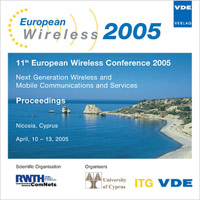Performance of TCP and HTTP Proxies in UMTS Networks
Konferenz: European Wireless 2005 - 11th European Wireless Conference 2005 - Next Generation wireless and Mobile Communications and Services
10.04.2006 - 13.04.2005 in Nicosia, Cyprus
Tagungsband: European Wireless 2005
Seiten: 7Sprache: EnglischTyp: PDF
Persönliche VDE-Mitglieder erhalten auf diesen Artikel 10% Rabatt
Autoren:
Necker, Marc; Scharf, Michael (Institute of Communication Networks and Computer Engineering, University of Stuttgart, Pfaffenwaldring 47, 70569 Stuttgart, Germany)
Weber, Andreas (Alcatel SEL AG, Research and Innovation, Lorenzstr. 10, 70435 Stuttgart, Germany)
Inhalt:
It is well known that the large round trip time and the highly variable delay in a cellular network may degrade the performance of TCP. Many concepts have been proposed to improve this situation, including performance enhancing proxies (PEP). One important class of PEPs are split connection proxies, which terminate a connection from a server in the Internet in a host close to the Radio Access Network (RAN) and establish a second connection towards the mobile User Equipment (UE). This connection splitting can be done either purely on the transport layer (TCP proxy) or on the application layer (HTTP proxy). While it is clear that an application layer proxy also infers the splitting of an underlying transport layer connection, the performance of web applications may be essentially different for both approaches. This paper first investigates the TCP connection behavior of the Mozilla web browser. Subsequently, the performance of TCP and HTTP proxies in UMTS networks is studied under different scenarios and for different HTTP configurations by means of emulation.


